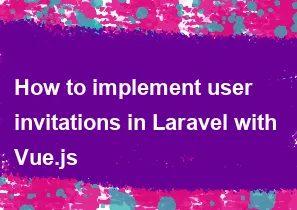How to implement user invitations in Laravel with Vue.js

Implementing user invitations in Laravel with Vue.js involves creating a system that generates unique invitation tokens, sending invitation emails, handling the registration process, and managing the state of invitations on the client side using Vue.js. Here's a step-by-step guide:
Laravel Backend:
Generate Migration and Model for Invitations:
- Run the following command to create a migration for the invitations table:bash
php artisan make:migration create_invitations_table - Define the fields in the migration file (
database/migrations/xxxx_xx_xx_create_invitations_table.php) and runphp artisan migrate.
- Run the following command to create a migration for the invitations table:
Create Invitation Model:
- Run the following command to create a model for invitations:bash
php artisan make:model Invitation
- Run the following command to create a model for invitations:
Implement InvitationController:
- Create a controller to handle invitation-related actions:bash
php artisan make:controller InvitationController - Implement methods for generating invitations, sending emails, and handling user registration.
- Create a controller to handle invitation-related actions:
API Routes:
- Define API routes in
routes/api.phpfor invitation-related actions.
- Define API routes in
Implement Invitations API Endpoints:
- Implement API endpoints in the
InvitationControllerfor generating invitations, sending emails, and handling registration.
- Implement API endpoints in the
Send Invitation Email:
- Use Laravel's Mail functionality to send an invitation email with a unique token.
Vue.js Frontend:
Set Up Vue Component:
- Create a Vue component to handle the frontend part of user invitations.
Form for Email Input:
- Create a form in your Vue component to collect the user's email for the invitation.
Call Laravel API:
- Use Axios or any other HTTP library to make requests to the Laravel API for sending invitations.
Handle Invitation Response:
- Handle the API response in the Vue component. If successful, provide feedback to the user. If there's an error, display an error message.
Registration Form:
- Create a registration form in the Vue component that allows users to register using the invitation token.
Call Laravel API for Registration:
- Use Axios to make requests to the Laravel API for handling user registration.
Handle Registration Response:
- Handle the API response in the Vue component. If registration is successful, redirect the user to the appropriate page. If there's an error, display an error message.
Security Considerations:
Token Expiry:
- Implement token expiry to enhance security. Tokens should be valid for a limited time.
Unique Tokens:
- Ensure that invitation tokens are unique and not easily guessable.
Secure API Endpoints:
- Secure the API endpoints using Laravel's authentication middleware.
Secure Email Communication:
- If sending emails with tokens, use secure methods to prevent token interception.
Example Flow:
- User enters their email in the Vue.js form.
- Vue.js sends a request to Laravel to generate an invitation for the provided email.
- Laravel generates a unique token, stores it in the database, and sends an email to the user.
- User clicks on the link in the email, which directs them to a registration form in the Vue.js app.
- User completes the registration form, and Vue.js sends a request to Laravel to handle the registration.
- Laravel verifies the token, registers the user, and sends a response to Vue.js.
- Vue.js handles the response and provides feedback to the user.
Make sure to handle errors gracefully and implement proper validation and error messages at each step. Additionally, consider adding features like token expiration, user-friendly error messages, and logging for better troubleshooting.
-
Popular Post
- How to optimize for Google's About This Result feature for local businesses
- How to implement multi-language support in an Express.js application
- How to handle and optimize for changes in mobile search behavior
- How to handle CORS in a Node.js application
- How to use Vue.js with a UI framework (e.g., Vuetify, Element UI)
- How to configure Laravel Telescope for monitoring and profiling API requests
- How to create a command-line tool using the Commander.js library in Node.js
- How to implement code splitting in a React.js application
- How to use the AWS SDK for Node.js to interact with various AWS services
- How to use the Node.js Stream API for efficient data processing
- How to implement a cookie parser middleware in Node.js
- How to implement WebSockets for real-time communication in React
-
Latest Post
- How to implement a dynamic form with dynamic field styling based on user input in Next.js
- How to create a custom hook for handling user interactions with the browser's device motion in Next.js
- How to create a custom hook for handling user interactions with the browser's battery status in Next.js
- How to implement a dynamic form with dynamic field visibility based on user input in Next.js
- How to implement a dynamic form with real-time collaboration features in Next.js
- How to create a custom hook for handling user interactions with the browser's media devices in Next.js
- How to use the useSWRInfinite hook for paginating data with a custom loading indicator in Next.js
- How to create a custom hook for handling user interactions with the browser's network status in Next.js
- How to create a custom hook for handling user interactions with the browser's location in Next.js
- How to implement a dynamic form with multi-language support in Next.js
- How to create a custom hook for handling user interactions with the browser's ambient light sensor in Next.js
- How to use the useHover hook for creating interactive image zoom effects in Next.js